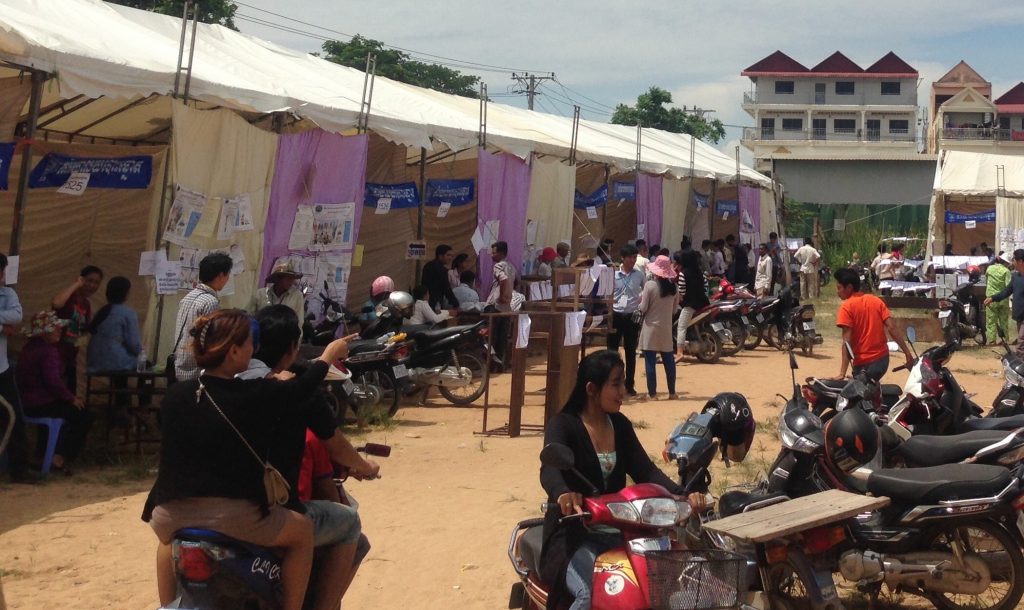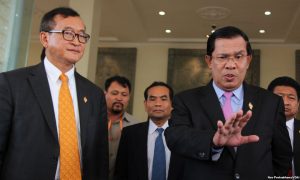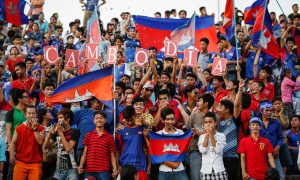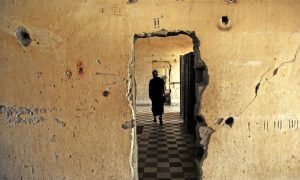On 4 June, Cambodia held its 4th commune elections. According to the National Election Committee (NEC), 7,040,594 people or 89.52% of registered voters—Cambodia’s highest-ever voter turnout rate—cast their votes in the country’s 1,646 local government areas, known as communes.
Eleven political parties fielded candidates in the election. However, only Prime Minister Hun Sen’s ruling Cambodian People’s Party (CPP) and the Cambodia National Rescue Party (CNRP) led by Kem Sokha and the self-exiled Sam Rainsy had the resources and extensive nation-wide organisational structure enabling them to field candidates to contest in all the communes. Based on the preliminary and unofficial results published in a government-affiliated media outlet Fresh News, the two major parties won all communes, except one which went to a small party.
The CPP led in 21 provinces, claiming victory of 1,163 communes to the CNRP’s control of 482 communes. The opposition led in Phnom Penh city, Siem Reap, and Kampong Cham provinces and won some communes in other provinces. However, when examining the popular vote, as tallied by the Situation Room, an election monitoring group of NGOs, the CPP received 48% to the CNRP’s 45%. In the previous commune elections in 2012, the Sam Rainsy Party and the Human Rights Party—which later merged to form today’s CNRP—won only a total of 40 communes to the CPP’s control of 1,592 out of the then 1,632 communes.
Despite the high stakes for both parties—for reasons which I will outline below—the 2017 commune elections went smoothly, with no major incidents reported. CNRP’s President Kem Sokha joined the campaign trail in the provinces and led more than 50,000 party supporters in a parade in Phnom Penh during the campaign’s last day (pictured below). Prime Minister Hun Sen, the CPP’s president, also led about 150,000 supporters through the streets of Phnom Penh on the last day. His participation in the campaign trail marked a major break from tradition, since he had chosen not to participate during election campaign seasons since 1998.
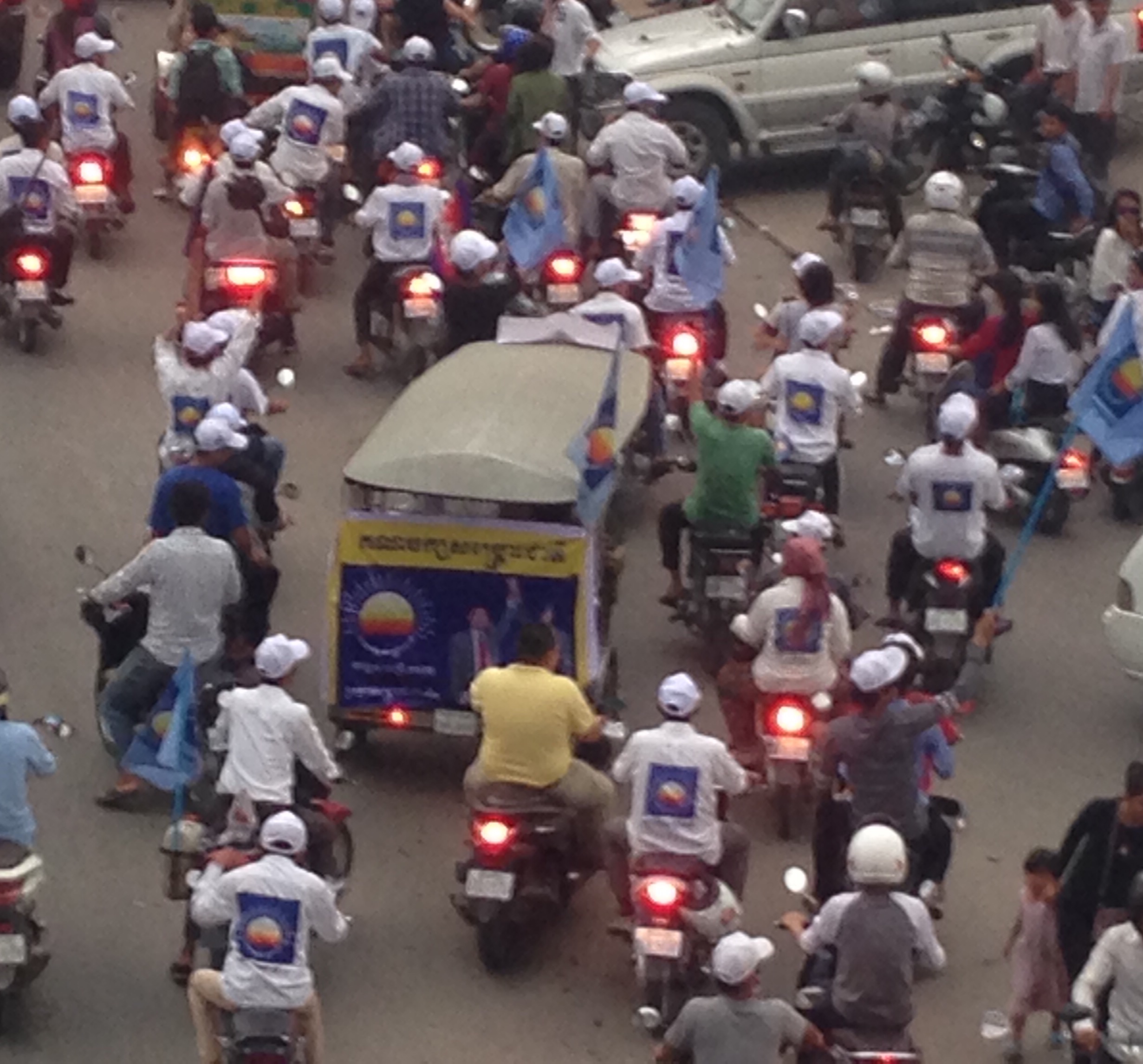
The prime minister’s direct participation in the campaign trail, Kem Sokha’s active leading of his party’s campaigns, and the high voter turnout attested the significance of this commune election for the future of the CPP and the CNRP and for the general population. When the preliminary election result was released by the local media, officials from both parties quickly claimed victory for their respective parties. The CPP argued that it won the election contest on the ground that it managed to stop the opposition party from winning more communes. If we expected a continuation of voting trends from the 2013 national election, the CNRP should have won many more communes. The ruling politicians interpreted it as an indication of voters’ turning their support back to the CPP. However, the opposition party claimed that it won the contest because it gained a more than tenfold increase in the number of communes under its control, if compared to the 2012 commune elections.
What kind of democracy is being consolidated?
This latest commune election was in many ways different from previous ones, and marked another milestone in Cambodia’s political and social transformations. To gain an understanding of how and why it has come to its current dynamics, it is worthwhile to sketch the electoral evolutions within Cambodia’s broader political and social contexts since the post-Cold War first national election in 1993.
Cambodia’s current electoral and democratic politics and practices are largely a product of complex interactions between diverse domestic and global actors, forces and processes over the last two decades. After the end of the Cold War and the 1991 Paris Peace Agreement, the United Nations and international communities implemented democratisation and post-conflict state building projects in Cambodia through such activities as administering the 1993 general election, supporting activities of civil society organisations, and providing development aid and annual financial assistance to the government. However, as implemented elsewhere, such projects rarely achieved their ideal expectations. The internationally-imposed liberal democratic discourses when introduced in post-conflict states are often susceptible to processes of localisation and manipulations by diverse and powerful interest groups.
Likewise, in Cambodia the 1993 election did not lead the country on the path to liberal democracy. Rather, it set the country on the course to a hybrid electoral regime or what political scientist Andreas Schedler calls electoral authoritarianism. Although the Funcinpec Party of Prince Norodom Ranariddh, Prince Norodom Sihanouk’s son, won the election, the ruling CPP refused to relinquish its control of state power to Funcinpec. Thus, a compromised political solution was hammered out with both parties forming a coalition government and Cambodia for the first time having co-prime ministers, Ranariddh and Hun Sen.
But that power sharing arrangement did not last long. Tension between both parties in the government intensified and broke out into open armed fighting in Phnom Penh in July 1997. Forces loyal to Hun Sen defeated Ranariddh’s quickly. Following that incident, the prince and his party became weak and moved into self-destruction mode. In contrast, Hun Sen emerged as Cambodia’s most powerful man and the country’s most skilled manipulator of electoral and patronage politics.
Hun Sen’s reinvention of himself from the mid 1990s saw him embarking on two important political projects as the backbone of his power consolidation: manipulating elections as a key political legitimation strategy, and building vast and complex patronage networks with key players in the bureaucracy, the armed forces, the private business sector, and local provincial power brokers.
Sitting on top of the sprawling patronage networks and having state resources at his disposal, Hun Sen directed resources to rural development projects throughout the country, building schools, roads, bridges, pagodas, houses and irrigation canals. The incumbent and his party machine also handed out cash, sewing machines, and electric generators—among many other items—to poor rural dwellers. All the items were communicated as omnaoy (gifts) from the prime minister, and they bore his name. Those gifts really responded to the everyday needs of the rural people in the context of post-conflict rural development. The prime minister crisscrossed the country to preside over the inaugurations of those development projects and usually gave lengthy impromptu speeches touching on aspects of war, peace, development, his rural background, and his political opponents. The speeches resonated very well with the rural audience. Therefore, the leader garnered mass popularity among rural voters and turned rural provinces into the CPP’s strong support bases, which guaranteed victories for his party in all subsequent elections.
On Hun Sen’s watch Cambodia has also experienced unprecedented economic and development and urbanisation. The country experienced strong annual economic growth of about 7% for a decade leading up to the 2013 elections. Foreign investments and tourists have increased every year, boosting and diversifying the national economy and increasingly integrating it into the global capitalist economic system. Phnom Penh’s urban economy and landscape have also experienced major transformations with the mushrooming of businesses and services, and a boom in construction of high rise buildings and borei (gated residential communities). The prime minister took great pride in these transformations and added them into his bucket of political legitimation narratives to win elections. Hun Sen has portrayed Cambodia under his watch as experiencing its most modern and joyful era.
As for the opposition forces, following the disintegration of Funcinpec, no credible political force could challenge Hun Sen in the arena of electoral politics. Though it was to emerge as a major opposition force, Sam Rainsy’s Khmer Nation Party, which was established in 1995 and later became the Sam Rainsy Party, remained weak and politically constrained from its formation until at least 2012. The party neither had an extensive organisational structure nor adequate financial resources to entice voters like the ruling CPP could. Sam Rainsy himself was often in self-exile to avoid court cases brought against him by the government. Some of his senior party members were vulnerable to enticement and cooptation by the government. Others who remained with the party needed to endure repression and hardship. Moreover, the party did not have concise policy platform for its election campaigns and was faced difficulties in spreading its message to voters since the CPP controlled almost all local media outlets. Therefore, Sam Rainsy often resorted to nationalist rhetoric accusing Hun Sen of being a Vietnamese ‘puppet’ and ‘damaging the Cambodian nation’ as a strategy to mobilise popular support to win elections. However, such rhetoric, and generally vague campaign messages about notions of nation, democracy, and accountable governance did not resonate well with the majority of voters who did not see the direct relationship between those big ideas and their daily needs.
Therefore, Hun Sen gained the upper hand in the electoral arena. National elections, as well as commune elections, which were introduced in 2002, became nothing but a legitimation mechanism justifying the incumbent’s extending his rule. Hun Sen’s CPP won in every election, from its landslide victory in the 2008 national election when it won 90 of the parliament’s 123 seats and in the 2012 commune election when the party gained control of 97% of communes. It looked like the elections gave the prime minister a mandate to rule Cambodia forever. Hun Sen declared that he would continue to rule until he was 90 (only later did he change his mind and say that he would rule until he was 74).
However, the result of the July 2013 national election surprised observers, shocked the CPP ruling elites, and changed the game of electoral politics in Cambodia. The ruling party’s control of seats in the parliament dropped to 68, while the opposition CNRP surged to 55. Moreover, the CNRP performed well in CPP’s rural strongholds leading it in at least three provinces.
Pundits attributed the surprising election outcome in favour of the opposition party mainly to demographic change and social media. They explained that a large number of voters were young and born after the Khmer Rouge regime. Therefore, they were not interested in Prime Minister Hun Sen’s narratives of war and peace. Furthermore, they were increasingly connected with each another on social media, thus bypassing the CPP-controlled media.
I contributed an article to New Mandala following the election that offered my analysis of the voters’ change of political allegiance to the CNRP. While I did not refute the pundits’ arguments, I was not convinced that generational change and social media necessarily led to change in political allegiance. What I saw was the CNRP’s concise policy platform of supporting family household incomes, which met people’s new life expectations. This policy triggered garment workers and ordinary public servants to convey the opposition’s policy messages to their rural localities and influenced their family members and fellow villagers to vote for the CNRP.
Besides, the economic and social transformations brought about by peace, economic development, and Cambodia’s increased integration into the global economy since the 1990s meant that by 2013 Cambodia had already moved beyond the post-conflict setting. People were adopting new lifestyles and identities and were seeking empowerment and upward mobility. Their aspirations could be realised only by having the opposition party in government. Therefore, the CPP’s gifts started to lose their magical appeal in the course of Cambodia’s evolving into a modern society and economy. A recent study by Swedish scholar Astrid Norén-Nilsson about Cambodian people’s perceptions of the ruling party’s gifts also found that gifts were generally viewed negatively by supporters of both parties. Voters had aspirations for programmatic policies.
Although the CNRP did not win the 2013 election, the result represented a major triumph in its push for control of state power, and a major setback for Hun Sen. The prospect of the prime minister’s losing power in the next election in 2018 seemed a real possibility if he did not reinvent himself and his party quickly enough.
The CPP’s comeback: how real is it?
Realising the potential threats to his power, Hun Sen placed some young, highly educated officials in control of several ministries and pledged to carry out ‘deep and comprehensive’ reforms. He has also increased salaries for public servants and members of the armed forces. Moreover, he supported the increase of minimum wage for garment factory workers. He tasked one of his sons to be in charge of mobilising youth to support the ruling party. The prime minister even made use of a popular Facebook page, and has since been active on social media posting photos, video clips, government announcements, and updates almost on a daily basis. He has also solved numerous complaints raised by people on his page.
Meanwhile, his government also used judicial repression against the CNRP’s leadership, NGO officers, and political analysts in what were widely believed as politically motivated actions. At least two MPs from the opposition party, along with 5 staff, have been put in jail. The CNRP’s former president Sam Rainsy was forced to flee Cambodia to avoid a series of court cases against him. Rainsy’s deputy Kem Sokha was forced to take refuge in the CNRP’s headquarters for months to avoid a court summons and was only allowed to walk free after a royal pardon from the king. On top of this, the ruling party’s MPs in the National Assembly hastily passed controversial amendments to the Law on Political Parties. The amended law allows the government to dissolve any political party if its leader is a convict or the party carries out activities considered as incitement that affects national unity. Analysts considered the law as a time bomb that may be used at any time to dissolve the CNRP.
However, the opposition party’s leadership have appeared to be less satisfied with the election outcome because it fell short of their expectations. Kem Sokha had expected that his party would win 60% of the communes in order to build his party’s momentum to succeed in the 2018 election. However, his expectations were politically unrealistic given the current domestic and international political contexts. His party’s leadership had been severely obstructed from running an effective opposition party after the 2013 election. Their attention focused largely on how to survive in the face of the judicial repression I described above, and how to keep the party’s senior members together from being split by the ruling elites. They had little time to ponder about policy and strategies to prepare themselves well for the 2017 commune election.
This manifested itself most clearly in their policy messages. Their so-called ‘five points’ policy was in many ways similar to that of the ruling party, aside from their pledge to allocate each commune throughout the country an annual budget of half a million US Dollars from the state budget for local development projects if the CNRP wins the 2018 election. However, this financial pledge was vague and did not appeal much to rural voters because it cannot be translated directly into an improvement to their livelihoods. If the money is to build schools, roads, and irrigation canals, then it’s not much different from Hun Sen’s gifts in the form of rural development projects. The CNRP needs to present itself as a much better option than the ruling party if it wants to gain more votes.
Somewhat paradoxically, the 2017 commune election’s result is good for the opposition party since it gives it political space to manoeuvre ahead of the 2018 national polls. A decisive victory for the CNRP would force the ruling party to adopt more repressive measures against the opposition and perhaps even dissolve it before next year election. The CPP can do this given the current international political contexts. The ruling party has relied increasingly on loans, financial aid, and political backing from China. Western governments’ political influence on the Cambodian government has been waning. In addition, with Donald Trump as the US president and Western countries being overwhelmed with immigration crises and terrorist attacks, it is unlikely that they are paying much attention to what is happening in Cambodia.
With all this context as a background, although the 2018 national election will be the most watched, it will likely not lead to a decisive victory for either of the two major parties. Both the ruling CPP and the CNRP have a whole range of their own opportunities and constraints in front of them. Moreover, next year’s election will not lead to war or prolonged political instability—as threatened by the ruling elites—because such instability is counterproductive to the ruling party’s economic interests and would undermine Prime Minister Hun Sen’s own patronage networks, whose members have amassed so much wealth and their own vast business empires. However, in the longer term, tensions may increase as the society and the private sector keeps changing so fast, while the ruling elites are changing so slowly.
……………
Kimly Ngoun is a lecturer at the Department of International Studies at the Royal University of Phnom Penh, and a PhD candidate at the Department of Political and Social Change in the ANU’s Coral Bell School of Asia Pacific Affairs.
All photographs taken by the author. Header image: voters attending a commune polling booth in Phnom Penh.
 Facebook
Facebook  Twitter
Twitter  Soundcloud
Soundcloud  Youtube
Youtube  Rss
Rss 